University Biology: Standard Curve, Electrophoresis, Dilution Homework
VerifiedAdded on 2023/01/16
|9
|1583
|88
Homework Assignment
AI Summary
This biology homework assignment analyzes a glycine standard curve generated using Excel, including the generation of a linear regression line, equation derivation, and concentration calculations. The assignment also explores the purpose and application of standard curves in biochemistry, along with an analysis of a Bovine Serum Albumin (BSA) standard curve, addressing its limitations and potential improvements. Additionally, the assignment covers the interpretation of an amino acid electrophoresis diagram, identifying the charged ends and the charge of the amino acids. Finally, the assignment requires a dilution calculation to prepare a threonine solution, including equation components, detailed working, and a final sentence answer.
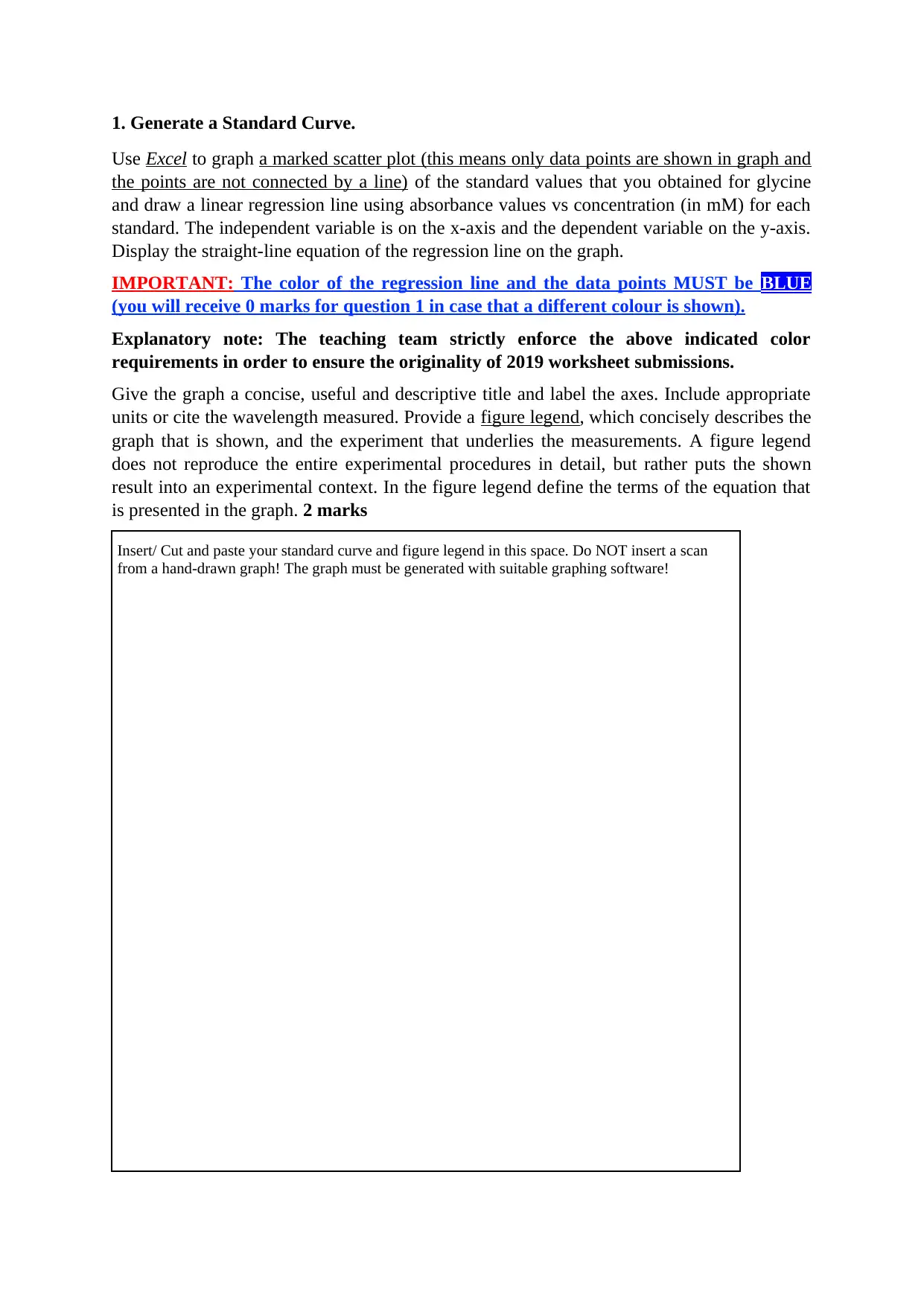
1. Generate a Standard Curve.
Use Excel to graph a marked scatter plot (this means only data points are shown in graph and
the points are not connected by a line) of the standard values that you obtained for glycine
and draw a linear regression line using absorbance values vs concentration (in mM) for each
standard. The independent variable is on the x-axis and the dependent variable on the y-axis.
Display the straight-line equation of the regression line on the graph.
IMPORTANT: The color of the regression line and the data points MUST be BLUE
(you will receive 0 marks for question 1 in case that a different colour is shown).
Explanatory note: The teaching team strictly enforce the above indicated color
requirements in order to ensure the originality of 2019 worksheet submissions.
Give the graph a concise, useful and descriptive title and label the axes. Include appropriate
units or cite the wavelength measured. Provide a figure legend, which concisely describes the
graph that is shown, and the experiment that underlies the measurements. A figure legend
does not reproduce the entire experimental procedures in detail, but rather puts the shown
result into an experimental context. In the figure legend define the terms of the equation that
is presented in the graph. 2 marks
Insert/ Cut and paste your standard curve and figure legend in this space. Do NOT insert a scan
from a hand-drawn graph! The graph must be generated with suitable graphing software!
Use Excel to graph a marked scatter plot (this means only data points are shown in graph and
the points are not connected by a line) of the standard values that you obtained for glycine
and draw a linear regression line using absorbance values vs concentration (in mM) for each
standard. The independent variable is on the x-axis and the dependent variable on the y-axis.
Display the straight-line equation of the regression line on the graph.
IMPORTANT: The color of the regression line and the data points MUST be BLUE
(you will receive 0 marks for question 1 in case that a different colour is shown).
Explanatory note: The teaching team strictly enforce the above indicated color
requirements in order to ensure the originality of 2019 worksheet submissions.
Give the graph a concise, useful and descriptive title and label the axes. Include appropriate
units or cite the wavelength measured. Provide a figure legend, which concisely describes the
graph that is shown, and the experiment that underlies the measurements. A figure legend
does not reproduce the entire experimental procedures in detail, but rather puts the shown
result into an experimental context. In the figure legend define the terms of the equation that
is presented in the graph. 2 marks
Insert/ Cut and paste your standard curve and figure legend in this space. Do NOT insert a scan
from a hand-drawn graph! The graph must be generated with suitable graphing software!
Paraphrase This Document
Need a fresh take? Get an instant paraphrase of this document with our AI Paraphraser

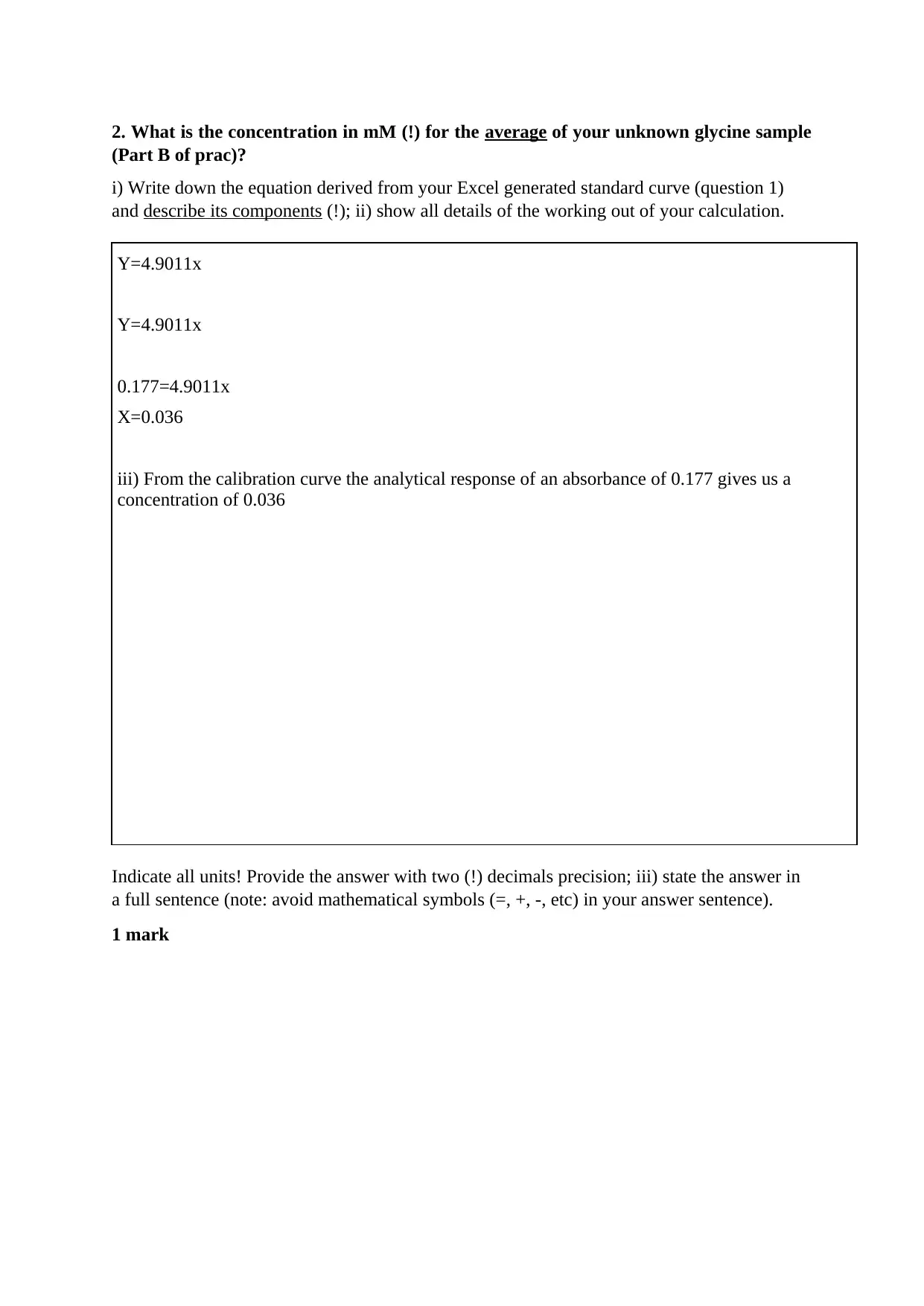
2. What is the concentration in mM (!) for the average of your unknown glycine sample
(Part B of prac)?
i) Write down the equation derived from your Excel generated standard curve (question 1)
and describe its components (!); ii) show all details of the working out of your calculation.
Indicate all units! Provide the answer with two (!) decimals precision; iii) state the answer in
a full sentence (note: avoid mathematical symbols (=, +, -, etc) in your answer sentence).
1 mark
Y=4.9011x
Y=4.9011x
0.177=4.9011x
X=0.036
iii) From the calibration curve the analytical response of an absorbance of 0.177 gives us a
concentration of 0.036
(Part B of prac)?
i) Write down the equation derived from your Excel generated standard curve (question 1)
and describe its components (!); ii) show all details of the working out of your calculation.
Indicate all units! Provide the answer with two (!) decimals precision; iii) state the answer in
a full sentence (note: avoid mathematical symbols (=, +, -, etc) in your answer sentence).
1 mark
Y=4.9011x
Y=4.9011x
0.177=4.9011x
X=0.036
iii) From the calibration curve the analytical response of an absorbance of 0.177 gives us a
concentration of 0.036
⊘ This is a preview!⊘
Do you want full access?
Subscribe today to unlock all pages.

Trusted by 1+ million students worldwide
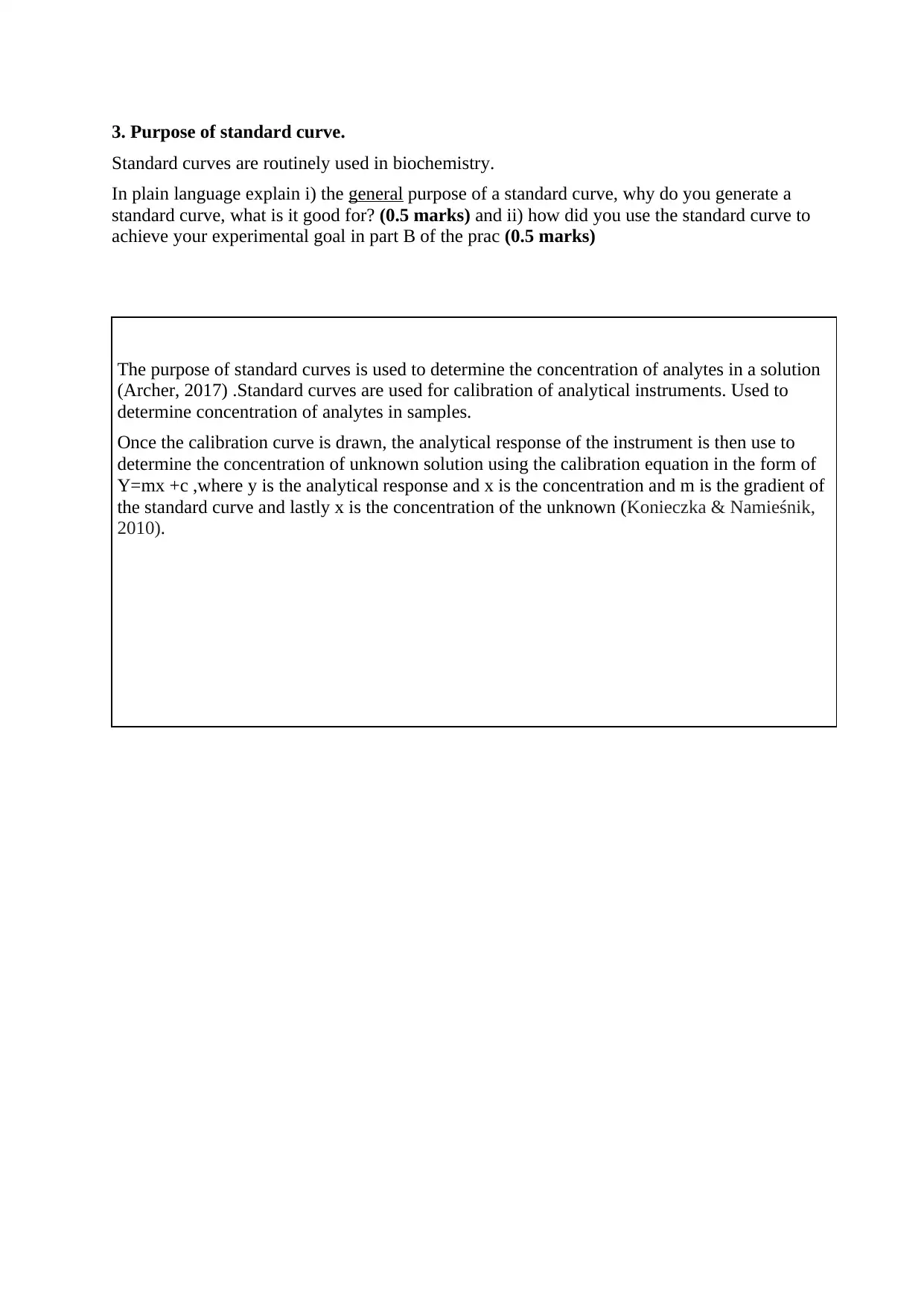
3. Purpose of standard curve.
Standard curves are routinely used in biochemistry.
In plain language explain i) the general purpose of a standard curve, why do you generate a
standard curve, what is it good for? (0.5 marks) and ii) how did you use the standard curve to
achieve your experimental goal in part B of the prac (0.5 marks)
The purpose of standard curves is used to determine the concentration of analytes in a solution
(Archer, 2017) .Standard curves are used for calibration of analytical instruments. Used to
determine concentration of analytes in samples.
Once the calibration curve is drawn, the analytical response of the instrument is then use to
determine the concentration of unknown solution using the calibration equation in the form of
Y=mx +c ,where y is the analytical response and x is the concentration and m is the gradient of
the standard curve and lastly x is the concentration of the unknown (Konieczka & Namieśnik,
2010).
Standard curves are routinely used in biochemistry.
In plain language explain i) the general purpose of a standard curve, why do you generate a
standard curve, what is it good for? (0.5 marks) and ii) how did you use the standard curve to
achieve your experimental goal in part B of the prac (0.5 marks)
The purpose of standard curves is used to determine the concentration of analytes in a solution
(Archer, 2017) .Standard curves are used for calibration of analytical instruments. Used to
determine concentration of analytes in samples.
Once the calibration curve is drawn, the analytical response of the instrument is then use to
determine the concentration of unknown solution using the calibration equation in the form of
Y=mx +c ,where y is the analytical response and x is the concentration and m is the gradient of
the standard curve and lastly x is the concentration of the unknown (Konieczka & Namieśnik,
2010).
Paraphrase This Document
Need a fresh take? Get an instant paraphrase of this document with our AI Paraphraser

4. Bovine Serum Albumin (BSA) standard curve. BSA is a protein that is frequently used
in laboratories to generate standard curves. The graph below shows such a BSA standard
curve that was generated with the use of the ninhydrine reagent as described in part B of the
practical. 2 marks total
a) i) Describe what happens to the relationship between BSA concentration and
absorbance at values higher than 0.1 mM BSA (0.5 marks) and ii) give a possible
explanation for the behaviour of the curve at these values (0.5 marks). (Hint: consider
what would happen when you apply the ninhydrine reagent to ever increasing
concentrations of BSA.) Total must be less than 100 words.
b) i) Why is the shown standard curve problematic for the faithful determination of
unknown concentrations of proteins? (0.5 marks); ii) What could be done quite easily
to correct this problem? (0.5 marks). Total must be less than 150 words.
i) At a concentration of 0.1 mM BSA the limit of linearity is surpassed hence
concentration and absorbance now ere not directly proportional i.e. further increase of
concentration doesn’t not cause a similar change or response on the absorbance (Liu
et al. 2012)
ii)At this point the calibration doesn’t obey the beer lambert law as a result of more
concentration of the analyte which causes interaction or chemical reaction hence the
calibration curve cease to be linear.
in laboratories to generate standard curves. The graph below shows such a BSA standard
curve that was generated with the use of the ninhydrine reagent as described in part B of the
practical. 2 marks total
a) i) Describe what happens to the relationship between BSA concentration and
absorbance at values higher than 0.1 mM BSA (0.5 marks) and ii) give a possible
explanation for the behaviour of the curve at these values (0.5 marks). (Hint: consider
what would happen when you apply the ninhydrine reagent to ever increasing
concentrations of BSA.) Total must be less than 100 words.
b) i) Why is the shown standard curve problematic for the faithful determination of
unknown concentrations of proteins? (0.5 marks); ii) What could be done quite easily
to correct this problem? (0.5 marks). Total must be less than 150 words.
i) At a concentration of 0.1 mM BSA the limit of linearity is surpassed hence
concentration and absorbance now ere not directly proportional i.e. further increase of
concentration doesn’t not cause a similar change or response on the absorbance (Liu
et al. 2012)
ii)At this point the calibration doesn’t obey the beer lambert law as a result of more
concentration of the analyte which causes interaction or chemical reaction hence the
calibration curve cease to be linear.
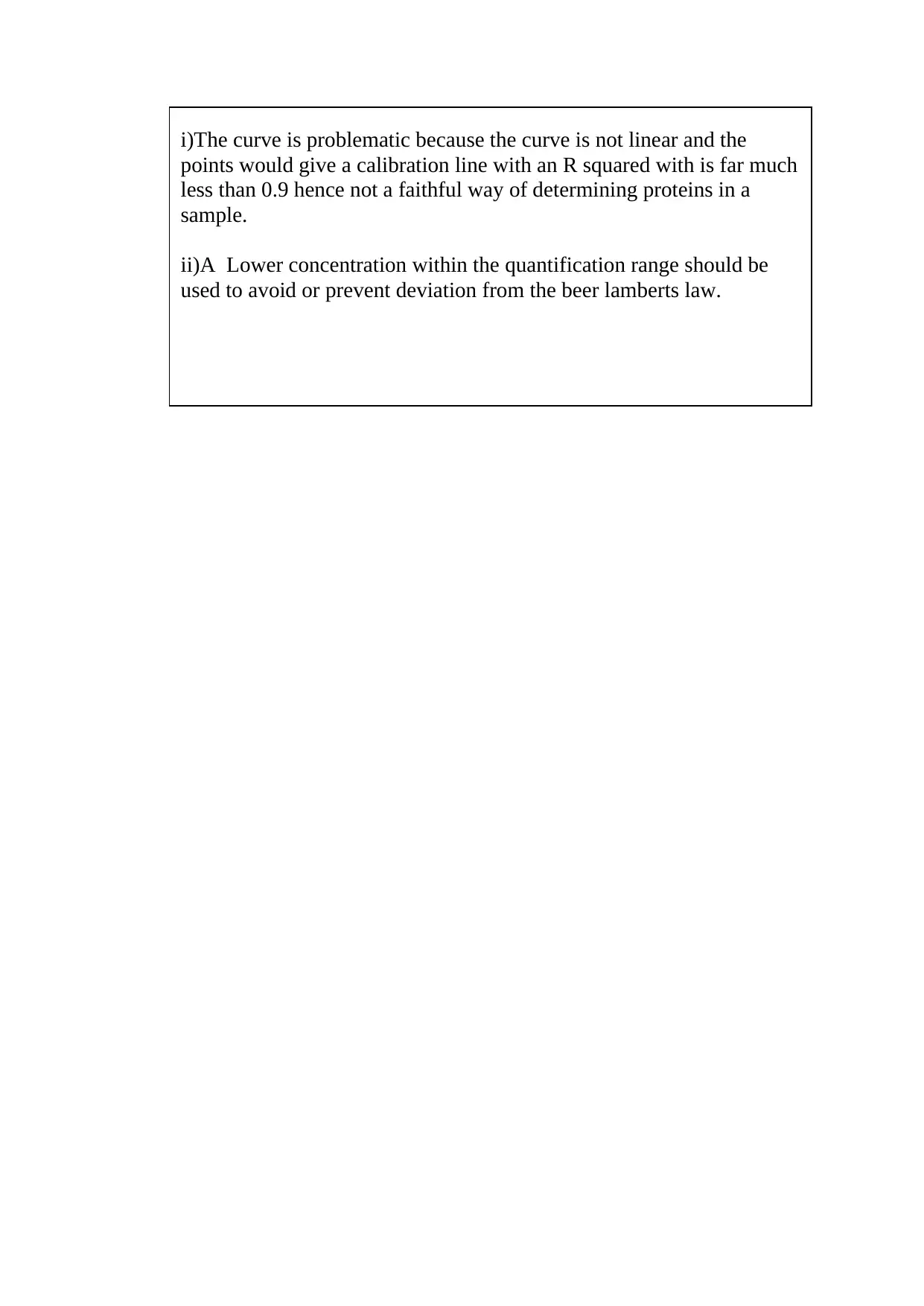
i)The curve is problematic because the curve is not linear and the
points would give a calibration line with an R squared with is far much
less than 0.9 hence not a faithful way of determining proteins in a
sample.
ii)A Lower concentration within the quantification range should be
used to avoid or prevent deviation from the beer lamberts law.
points would give a calibration line with an R squared with is far much
less than 0.9 hence not a faithful way of determining proteins in a
sample.
ii)A Lower concentration within the quantification range should be
used to avoid or prevent deviation from the beer lamberts law.
⊘ This is a preview!⊘
Do you want full access?
Subscribe today to unlock all pages.

Trusted by 1+ million students worldwide
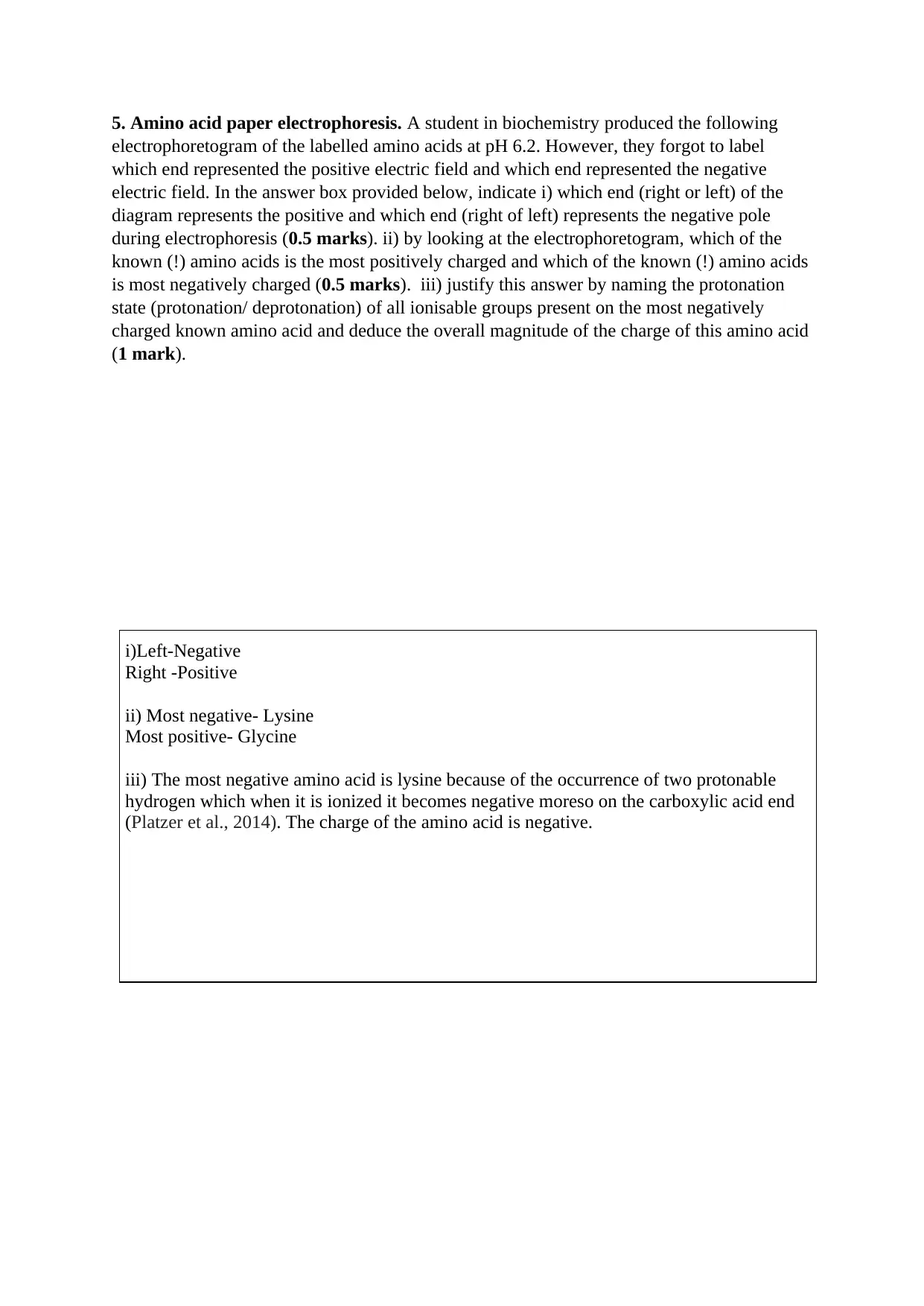
5. Amino acid paper electrophoresis. A student in biochemistry produced the following
electrophoretogram of the labelled amino acids at pH 6.2. However, they forgot to label
which end represented the positive electric field and which end represented the negative
electric field. In the answer box provided below, indicate i) which end (right or left) of the
diagram represents the positive and which end (right of left) represents the negative pole
during electrophoresis (0.5 marks). ii) by looking at the electrophoretogram, which of the
known (!) amino acids is the most positively charged and which of the known (!) amino acids
is most negatively charged (0.5 marks). iii) justify this answer by naming the protonation
state (protonation/ deprotonation) of all ionisable groups present on the most negatively
charged known amino acid and deduce the overall magnitude of the charge of this amino acid
(1 mark).
i)Left-Negative
Right -Positive
ii) Most negative- Lysine
Most positive- Glycine
iii) The most negative amino acid is lysine because of the occurrence of two protonable
hydrogen which when it is ionized it becomes negative moreso on the carboxylic acid end
(Platzer et al., 2014). The charge of the amino acid is negative.
electrophoretogram of the labelled amino acids at pH 6.2. However, they forgot to label
which end represented the positive electric field and which end represented the negative
electric field. In the answer box provided below, indicate i) which end (right or left) of the
diagram represents the positive and which end (right of left) represents the negative pole
during electrophoresis (0.5 marks). ii) by looking at the electrophoretogram, which of the
known (!) amino acids is the most positively charged and which of the known (!) amino acids
is most negatively charged (0.5 marks). iii) justify this answer by naming the protonation
state (protonation/ deprotonation) of all ionisable groups present on the most negatively
charged known amino acid and deduce the overall magnitude of the charge of this amino acid
(1 mark).
i)Left-Negative
Right -Positive
ii) Most negative- Lysine
Most positive- Glycine
iii) The most negative amino acid is lysine because of the occurrence of two protonable
hydrogen which when it is ionized it becomes negative moreso on the carboxylic acid end
(Platzer et al., 2014). The charge of the amino acid is negative.
Paraphrase This Document
Need a fresh take? Get an instant paraphrase of this document with our AI Paraphraser
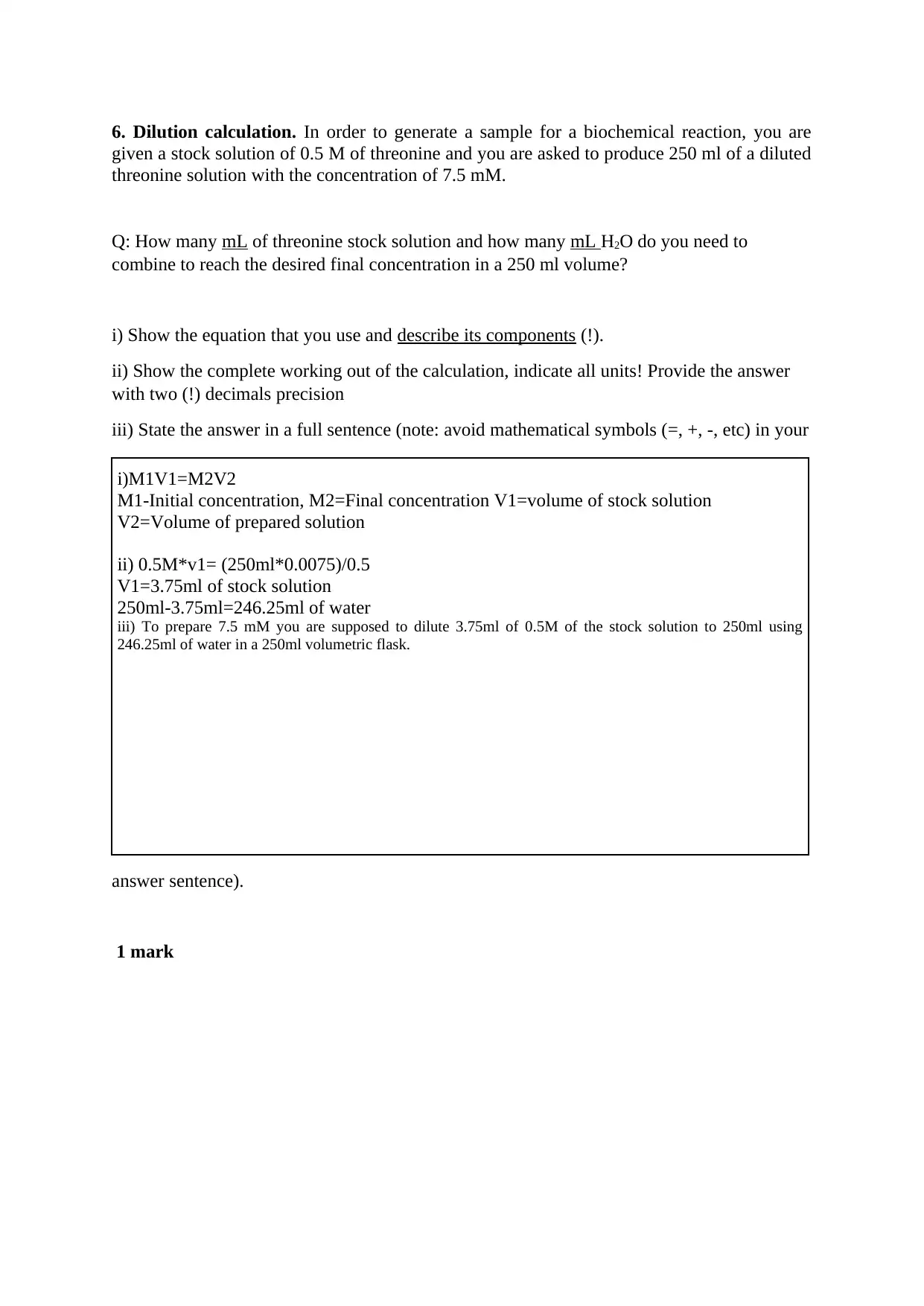
6. Dilution calculation. In order to generate a sample for a biochemical reaction, you are
given a stock solution of 0.5 M of threonine and you are asked to produce 250 ml of a diluted
threonine solution with the concentration of 7.5 mM.
Q: How many mL of threonine stock solution and how many mL H2O do you need to
combine to reach the desired final concentration in a 250 ml volume?
i) Show the equation that you use and describe its components (!).
ii) Show the complete working out of the calculation, indicate all units! Provide the answer
with two (!) decimals precision
iii) State the answer in a full sentence (note: avoid mathematical symbols (=, +, -, etc) in your
answer sentence).
1 mark
i)M1V1=M2V2
M1-Initial concentration, M2=Final concentration V1=volume of stock solution
V2=Volume of prepared solution
ii) 0.5M*v1= (250ml*0.0075)/0.5
V1=3.75ml of stock solution
250ml-3.75ml=246.25ml of water
iii) To prepare 7.5 mM you are supposed to dilute 3.75ml of 0.5M of the stock solution to 250ml using
246.25ml of water in a 250ml volumetric flask.
given a stock solution of 0.5 M of threonine and you are asked to produce 250 ml of a diluted
threonine solution with the concentration of 7.5 mM.
Q: How many mL of threonine stock solution and how many mL H2O do you need to
combine to reach the desired final concentration in a 250 ml volume?
i) Show the equation that you use and describe its components (!).
ii) Show the complete working out of the calculation, indicate all units! Provide the answer
with two (!) decimals precision
iii) State the answer in a full sentence (note: avoid mathematical symbols (=, +, -, etc) in your
answer sentence).
1 mark
i)M1V1=M2V2
M1-Initial concentration, M2=Final concentration V1=volume of stock solution
V2=Volume of prepared solution
ii) 0.5M*v1= (250ml*0.0075)/0.5
V1=3.75ml of stock solution
250ml-3.75ml=246.25ml of water
iii) To prepare 7.5 mM you are supposed to dilute 3.75ml of 0.5M of the stock solution to 250ml using
246.25ml of water in a 250ml volumetric flask.
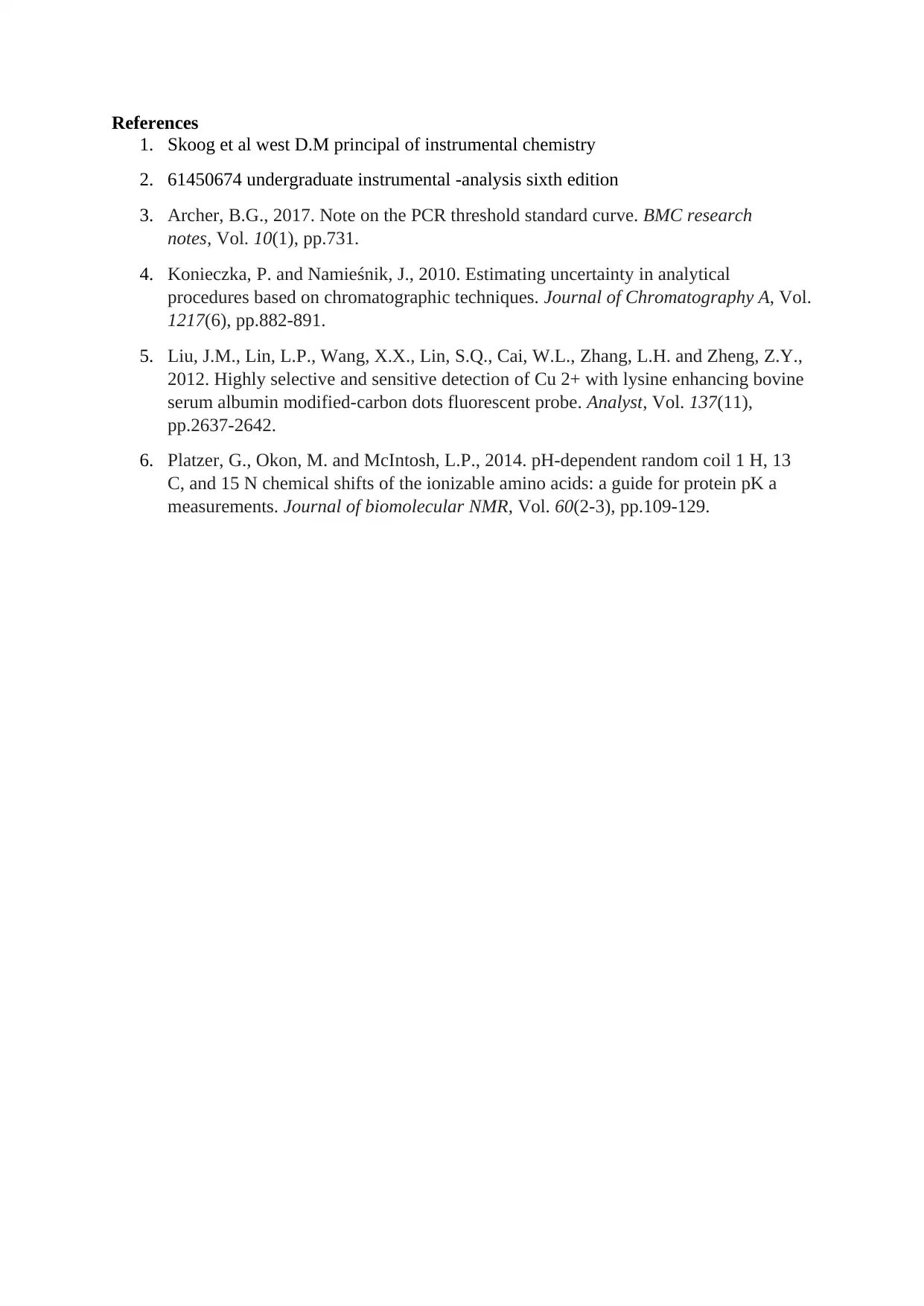
References
1. Skoog et al west D.M principal of instrumental chemistry
2. 61450674 undergraduate instrumental -analysis sixth edition
3. Archer, B.G., 2017. Note on the PCR threshold standard curve. BMC research
notes, Vol. 10(1), pp.731.
4. Konieczka, P. and Namieśnik, J., 2010. Estimating uncertainty in analytical
procedures based on chromatographic techniques. Journal of Chromatography A, Vol.
1217(6), pp.882-891.
5. Liu, J.M., Lin, L.P., Wang, X.X., Lin, S.Q., Cai, W.L., Zhang, L.H. and Zheng, Z.Y.,
2012. Highly selective and sensitive detection of Cu 2+ with lysine enhancing bovine
serum albumin modified-carbon dots fluorescent probe. Analyst, Vol. 137(11),
pp.2637-2642.
6. Platzer, G., Okon, M. and McIntosh, L.P., 2014. pH-dependent random coil 1 H, 13
C, and 15 N chemical shifts of the ionizable amino acids: a guide for protein pK a
measurements. Journal of biomolecular NMR, Vol. 60(2-3), pp.109-129.
1. Skoog et al west D.M principal of instrumental chemistry
2. 61450674 undergraduate instrumental -analysis sixth edition
3. Archer, B.G., 2017. Note on the PCR threshold standard curve. BMC research
notes, Vol. 10(1), pp.731.
4. Konieczka, P. and Namieśnik, J., 2010. Estimating uncertainty in analytical
procedures based on chromatographic techniques. Journal of Chromatography A, Vol.
1217(6), pp.882-891.
5. Liu, J.M., Lin, L.P., Wang, X.X., Lin, S.Q., Cai, W.L., Zhang, L.H. and Zheng, Z.Y.,
2012. Highly selective and sensitive detection of Cu 2+ with lysine enhancing bovine
serum albumin modified-carbon dots fluorescent probe. Analyst, Vol. 137(11),
pp.2637-2642.
6. Platzer, G., Okon, M. and McIntosh, L.P., 2014. pH-dependent random coil 1 H, 13
C, and 15 N chemical shifts of the ionizable amino acids: a guide for protein pK a
measurements. Journal of biomolecular NMR, Vol. 60(2-3), pp.109-129.
⊘ This is a preview!⊘
Do you want full access?
Subscribe today to unlock all pages.

Trusted by 1+ million students worldwide
1 out of 9
Related Documents
Your All-in-One AI-Powered Toolkit for Academic Success.
+13062052269
info@desklib.com
Available 24*7 on WhatsApp / Email
![[object Object]](/_next/static/media/star-bottom.7253800d.svg)
Unlock your academic potential
Copyright © 2020–2025 A2Z Services. All Rights Reserved. Developed and managed by ZUCOL.





